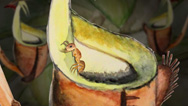Mushroom Material
- Posted 10.17.13
- NOVA
A company called Ecovative hopes to replace plastic packaging material with an eco-friendly alternative—one that's grown from mushrooms. Making Stuff host David Pogue met with the company's co-founder for a look at how fungus could be the future of green shipping.
Transcript
Mushroom Material
October 17, 2013
NARRATOR: Foamed polystyrene, or Styrofoam as we usually call it, is found in cups, take out containers, and lots of packaging. It’s a plastic that’s made from petroleum or natural gas. This prolific plastic is incredibly stable and takes a long time to breakdown—perhaps hundreds of years, no one’s quite sure—causing a serious trash problem.
But Eben Bayer has an idea for how to solve it. He’s co-founded a company called “Ecovative,” which produces eco-friendly packaging. And, it’s not made from petroleum—it’s grown from part of a mushroom. Making Stuff host, David Pogue, visited him at his factory in Upstate New York.
EBEN BAYER (co-founder, Ecovative): Well what’s really unique about the mushrooms is that they have something, a root structure called mycelium, and if you look here, this is actually mycelium in progress we dug up from a wood-chip pile. And you can see it forms these strands.
NARRATOR: Mycelium is made up of repeating threadlike cells called hyphae that provide structure, bind materials, and digest organic waste. In nature, it serves a vital role in the ecosystem, breaking these material down into simple nutrients. But at Ecovative, adding products like rice husks and cotton-seed hulls to the mycelium is the start of turning these waste products into natural packaging materials.
DAVID POGUE: How does the mushroom enter into all this?
EBEN BAYER: Well basically the mushroom is the glue that holds this together, and this is also the food for the mushroom. So they sort of meld into a single composite.
DAVID POGUE: I see so these are the bricks and the mushroom's roots are the glue that holds them together.
EBEN BAYER: Exactly. It’s the mortar.
NARRATOR: They mix the waste with mushroom mycelium and let it grow for a few days. Then they break it up into smaller particles that will be molded into packaging. Over the next few days, the mycelium will feed off the organic waste, binding it into a solid. Finally, the piece of packaging is popped out of the mold, and treated with heat to kill the mushrooms so they stop growing.
Right now the focus is on packaging, but they’re also making biodegradable marine buoys. And, that may be just the start. Ecovative is also exploring what you might call "myco-struction."
EBEN BAYER: So we’re actually using the living material as insulation in these walls and as the structural material.
DAVID POGUE: There’s no nails, no nothing.
EBEN BAYER: It’s all glued together with mycelium. So all the way up through the roof we blew in that living material you played with earlier, and it glued the whole building together.
NARRATOR: Ecovative’s materials have a lot going for them. As packaging they about equal polystyrene in cost and performance. And they can breakdown in a compost pile in as little as 30 days. In a landfill, they take longer—about the same amount of time as other natural materials. One consideration is weight—no mushroom material weighs as little as the lightest Styrofoam. Still, companies as big as Dell computer and Crate and Barrel have taken some orders.
DAVID POGUE: This could make a real dent in the way we do things and the way we discard things, but are you big enough to make even a percent of a percent difference?
EBEN BAYER: Today, we are not. But the vision behind this is make it cost-competitive, make it technically-competitive, then it’s an economic proposition. And our secret goal here at Ecovative is we want to get rid of disposable plastics.
Credits
PRODUCTION CREDITS
- Special Thanks to
- Gavin McIntyre, co-founder Ecovative
- Cinematography by
- Thorsten Thielow
- Sound by
- John Garrett
- Narrated by
- Anna Rothschild
- Original Footage
- © WGBH Educational Foundation 2013
MEDIA CREDITS
- (mushroom timelapse)
- © Ecovative
- (mold)
- Wikimedia Commons/Bob Blaylock (CC BY-SA 3.0)
- (A niger hyphae)
- Wikimedia Commons/Y tambe (CC BY-SA 3.0)
IMAGE
- (main image: mold)
- Wikimedia Commons/Bob Blaylock (CC BY-SA 3.0)
Related Links
-

Making More Stuff
Host David Pogue hits the road to explore the frontiers of invention and innovation.
-

RoboBees to the Rescue
Could tiny drones be the pollinators of the future?
-

Clothing from Slime?
Super-strong hagfish slime might become the fabric of the future.
-

Carnivorous Plants, Killer Ants
Ant eats plant's parasites. Plant eats ant's poop. It's the circle of life.

